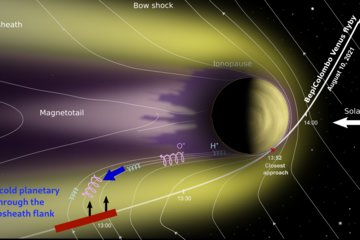All genres
161.
Journal Article
Capabilities and limitations of EISCAT as an MST radar. Handbook for MAP 9, pp. 305 - 314 (1983)
162.
Journal Article
VHF Radar Observations of Wind Velocities at the Arecibo Observatory. Journal Geophysical Research 52, pp. 34 - 39 (1983)
163.
Journal Article
VHF and UHF Doppler radars as tools for synoptic research. Bull. Amer. Meteor. Soc. 63, pp. 996 - 1008 (1982)
164.
Journal Article
VHF radar observations of coherent reflections in the vicinity of the tropopause. Journal of Atmospheric and Terrestrial Physics 44, pp. 461 - 469 (1982)
165.
Journal Article
Gravity waves seeding ionospheric irregularities. Nature 296 (5853), pp. 111 - 112 (1982)
166.
Journal Article
Investigations of lower and middle atmosphere dynamics with spaced antenna drifts radars. Journal of Atmospheric and Terrestrial Physics 43, pp. 277 - 292 (1981)
167.
Journal Article
Equatorial spread-F by electric fields and atmospheric gravity waves generated by thunderstorms. Journal of Atmospheric and Terrestrial Physics 43, pp. 453 - 462 (1981)
168.
Journal Article
First low power VHF radar observations of tropospheric, stratospheric and mesospheric winds and turbulence at the Arecibo Observatory. Journal of Atmospheric and Terrestrial Physics 43, pp. 789 - 800 (1981)
169.
Journal Article
Structure and dynamics of the stratosphere and mesosphere revealed by VHF radar investigations. J. Pure Appl. Geophys. 118, pp. 494 - 527 (1980)
170.
Journal Article
Reflection and scattering of VHF radar signals from atmospheric refractivity structures. Radio Science 15, pp. 259 - 276 (1980)
171.
Journal Article
Spaced antenna VHF radar observations of tropospheric velocities and irregularities. Radio Science 15, pp. 319 - 335 (1980)
172.
Journal Article
A coherent integrator-decoder preprocessor for the SOUSY-VHF-Radar. Radio Science 15, pp. 233 - 242 (1980)
173.
Journal Article
VHF-Radar erkundet die Atmosphäre. Umschau 79, pp. 514 - 515 (1979)
174.
Journal Article
VHF radar observations of a trontal passage. J. Appl. Meteor. 18, pp. 85 - 91 (1979)
175.
Journal Article
High-resolution VHF radar observations of turbulence structures in the mesosphere. Geophysical Research Letters 6, pp. 617 - 620 (1979)
176.
Journal Article
High-resolution VHF radar sounding of the troposphere and stratosphere. IEEE Trans. Geosc. Remote Sensing GE-17, pp. 182 - 189 (1979)
177.
Journal Article
Evidence for partial reflection of VHF radar signals from the troposphere. Journal Geophysical Research 44, pp. 393 - 394 (1978)
178.
Journal Article
Drifting patches of equatorial spread-F irregularities -experimental support for the spatial resonance mechanism in the ionosphere. Journal of Atmospheric and Terrestrial Physics 40, pp. 1103 - 1112 (1978)
179.
Journal Article
VHF-radar echoes from the troposphere and stratosphere. Kleinheubacher Berichte 21, pp. 279 - 290 (1978)
180.
Journal Article
Remote Sensing of the Atmosphere by VHF Radar Experiments. Naturwissenschaften 65, pp. 285 - 296 (1978)











